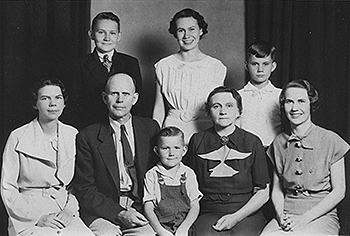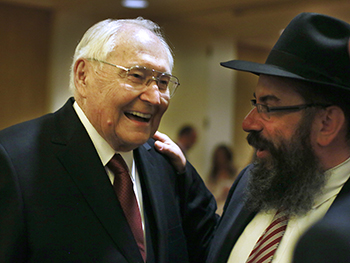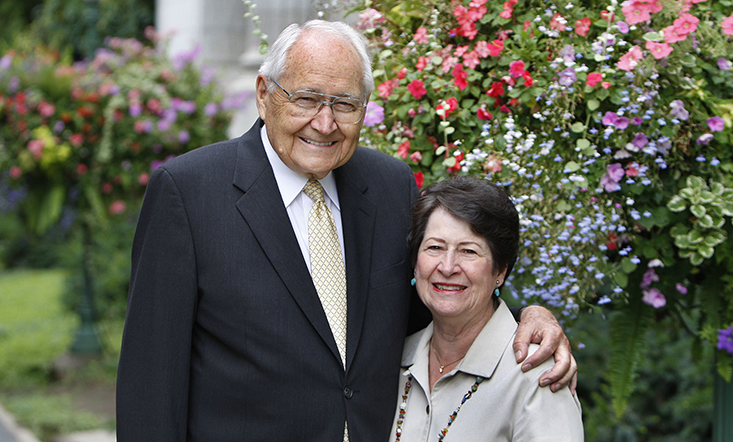“We Should Never Be Downcast,” Said the Late Elder Perry
Contributed By R. Scott Lloyd, LDS Church News staff writer
Elder Perry, who died Saturday, May 30, 2015, was known for his optimism and his ever-present smile.
Article Highlights
- Elder Perry, who died May 30, 2015, was known for his optimism and his ever-present smile.
- He was reared in a home in which his parents loved and appreciated the gospel of Jesus Christ.
- He applied his positive attitude to everything he did, whether in the business world, the Church, or his own family.
- While Elder Perry has done incredible acts of service, he still managed to help numerous people on an individual level.
“The Lord has designed a plan for us that gives eternal opportunities. My goodness, we should never be downcast.” —Elder L. Tom Perry of the Quorum of the Twelve
Related Links
A buoyant and irrepressible optimism reflected in an ever-present smile and a resounding witness of the reality of God, the divinity of Jesus Christ, and the eternal nature of the family unit characterized the life of Elder L. Tom Perry, who died May 30, 2015. (Funeral details.)
Addressing the general conference congregation two days after being sustained the newest member of the Quorum of the Twelve Apostles on April 6, 1974, Elder Perry was reflective and emotional.
As a child in Primary, he said, he was required to memorize the names of the Quorum of the Twelve Apostles. His father taught him about the life of each man in the quorum.
“As I was thinking about this assignment, I thought, what if there is some father in the Church who would like to spend some time in family home evening telling about the current members of the Council of the Twelve?” Elder Perry said. “This thought startled me. What could he ever tell about me?”
Elder Perry concluded that there was a theme about his boyhood that might be of value to young children learning about him. “It is this: He was reared in a home in which his parents loved and appreciated the gospel of Jesus Christ. They understood the admonition of Paul to the Ephesian saints when he wrote, ‘Finally, my brethren, be strong in the Lord, and in the power of his might.’”
Lowell Tom Perry was born August 25, 1922, in Logan, Utah, to Leslie Thomas Perry and Elsie Nora Sonne Perry, the fourth child and eldest son in a family of six children.
He received his bachelor’s degree in finance from Utah State Agricultural College (now Utah State University) in Logan in 1949 and did graduate work there, meanwhile taking time out for two years of service in the Northern States Mission beginning in 1942, followed by a two-year stint in the United States Marine Corps at the end of World War II.
After that, in 1947, he married Virginia Lee of Hyde Park, Utah, in the Logan Utah Temple. They would rear two sons and a daughter.
He distinguished himself with a successful career in retail business, serving as a vice president and treasurer of companies in Idaho, California, New York, and Massachusetts.
During that time, he rendered faithful Church service as a counselor in a bishopric in Idaho, a counselor in a stake presidency in Sacramento, California, a high councilor in the New York Stake, and president of the Boston Stake in Massachusetts.

Elder L. Tom Perry with his wife, Virgina, and family. Photo courtesy of the Perry family.
His service as a General Authority began October 6, 1972, with his call as an Assistant to the Twelve, which service would last 18 months until April 6, 1974, when he was called as a member of the Quorum of the Twelve Apostles.

Young Tom Perry (top row, left) with his parents, brothers, and sisters.
Eight months later, in December 1974, he suffered the death of his wife. He remarried in 1976 to Barbara Taylor Dayton, who would be his companion for the rest of his life.
Elder Perry came from pioneer stock. His family was steeped in devotion to the gospel. His mother’s brother, Alma Sonne, became a General Authority. Elder Perry would briefly serve with him in the position of Assistant to the Council of the Twelve.
Elder Perry learned early to work and to build. As a Depression-era bishop of the Logan 9th Ward, his father boldly sought and received approval from Church leaders to embark on a building project to add a chapel onto the existing cultural hall. The facility was needed, but part of the intent was to build unity in the ward and provide badly needed employment for some of the skilled craftsmen in the ward.
“I began hearing stories about building the Logan 9th Ward chapel when I was very young,” wrote Lee Tom Perry, Elder Perry’s son and biographer, “and I have since concluded that the experience affected my father deeply and permanently. Many of my father’s unique strengths as a leader can be traced to lessons learned from his father as he led the members … during the chapel-building project. My father learned about faith, compassion, and unity of purpose.”

When Tom Perry (back center) served as a member of the United States Marine Corps during World War II, he and other servicemen helped repair Christian churches damaged from the war.
His mother also taught through example and hands-on experience. “Mother was a great one for compassionate service,” Elder Perry was quoted as saying in an August 1986 Ensign magazine article. “She went around all the time helping people who were having difficulty, and she liked to take us with her. She would put us to work washing windows, dusting, vacuuming rugs—things children could do without difficulty.”
One of the formative experiences for young L. Tom Perry was a youth excursion to the cemetery in nearby Clarkston, where Martin Harris, one of the Three Witnesses to the Book of Mormon, is buried. William Pilkington, who as a youth had met Brother Harris, spoke to the group.
“Tom’s testimony of the truthfulness of the Book of Mormon became more resolute and steadfast after that Aaronic Priesthood outing to Clarkston,” Lee Perry wrote.
While a student at Logan High School, Tom Perry tried out for the ward volleyball team. What he lacked in skill, he made up for in enthusiasm. After a few years, he became team captain and, imbuing the other members of the team with his infectious spirit, led them to victory in the all-Church tournament.

Elder L. Tom Perry welcomes young people as they enter the Tabernacle on Temple Square April 1976. Photo courtesy of Deseret News archives.
Elder Perry attended Utah State Agricultural College in Logan for a year.
He then would have the unique experience of being interviewed for missionary service by his Uncle Alma Sonne, of the first five Assistants to the Twelve, and by his own father, who had been called as a member of the Cache Valley Stake presidency but had not yet been released as bishop. In both capacities, he interviewed his son for the mission.
Just before Elder Perry began his missionary service, the Japanese attack on Pearl Harbor on December 7, 1941, began the involvement of the United States in World War II. Thus, he was embarking on four years away from home, two years on a mission and two in the military. Both experiences would be memorable and formative.
“It was natural for him to identify with Joseph and Daniel of the Old Testament,” wrote Lee Perry. “Their courage and unwavering faith in the face of adversity were an inspiration to him.”

Elder L. Tom Perry, left, shares a laugh with Rabbi Benny Zippel at the Little America Hotel for a Utah Catholic Community Services Awards event on November 6, 2014, in Salt Lake City. Photo by Hugh Carey, Deseret News.
In an interview with Sheri Dew on the Mormon Channel of ChurchofJesusChrist.org, Elder Perry said, “I had a very special companion in the mission field [Wendell Tolman]. We served together for 10 months. When we were separated we both decided we would come home and join the navy, because we both knew we were going into military service.”
But at the induction center, he made a spur-of-the-moment decision to volunteer for the U.S. Marine Corps, deciding that the marine uniform would suit his long legs better than the bell-bottomed trousers of the navy uniform. As he would learn later, his former missionary companion also joined the marines.
On the island of Saipan, he and Wendell spearheaded an effort to build a small chapel for the LDS servicemen stationed there.
“Even more impressive than the building itself were the effects on the spirits of the servicemen as they worked together,” Lee Perry wrote. “Less-active servicemen, who had been reluctant to attend church on Sunday, joined the project. Even several nonmembers, upon seeing the spirit of brotherhood generated from the project, asked to join the effort.”
Later, in the devastated city of Nagasaki, Japan, Tom and Wendell repeated the service on a grander scale, leading an effort of mostly LDS servicemen to repair and re-plaster chapels of Christian churches during their off-duty hours. They also assisted some of Nagasaki’s orphans rendered homeless by the war.

Elder Perry grins during an October 2014 Saturday session of general conference. Photo by Kristin Murphy, Deseret News.
In the “Special Witnesses of Christ” video produced by the Church, Elder Perry would recall his experience on the day he and Wendell were to depart Nagasaki to return home.
“Up over a rise near the train station came about 200 of these great Japanese Christians from the churches we had repaired,” he said, “singing ‘Onward Christian Soldiers.’ They came down and showered us with gifts. Then they lined up along the railroad track, and as the train started down the tracks, we reached out and just touched their fingers as we left. We couldn’t speak; our emotions were too strong. But we were grateful we could help in some small way in reestablishing Christianity in a nation after the war.”

Elder L. Tom Perry, center, visits with friends at the Little America Hotel for a Utah Catholic Community Services Awards event on November 6, 2014, in Salt Lake City. Photo by Hugh Carey, Deseret News.
Whether in his Church service or in his retail career, Elder Perry was an exemplary Latter-day Saint.
“I started in a very small organization in Idaho, then grew to a larger one in California and then a giant one in New York,” he reflected in the Mormon Channel interview. “And then I didn’t like that so well, so I went back to smaller units in Boston.
“But each one has taught me a principle that has been so valuable in my life. The first principle is how to get along with people, how to motivate people. And the secret is never having a dull day. Always be on top of the world. Every day when you walk into the office, walk in like you’re full of enthusiasm, spirit. Pat everyone on the back, try to make them feel good, and then be very sensitive to their needs and try to teach a feeling of warmth and encouragement to everyone.”
It was an outlook that stemmed from his faith.
“The Lord has designed a plan for us that gives eternal opportunities,” he said. “My goodness, we should never be downcast, because we know that we’re in control. He’s bound to give us the blessings of heaven, providing we’ll live up to a certain standard and follow His teachings. Why wouldn’t we be happy and excited about the way life is going on?”

Elder L. Tom Perry and his wife, Barbara, at the close of the afternoon session of the 183rd Semiannual General Conference of the Church on Oct. 5, 2013. Photo by Tom Smart, Deseret News.

Elder L. Tom Perry greets Bishop Darin J. Walker of the Washington Fields (Utah) 12th Ward, during a priesthood leadership conference in St. George, Utah, on December 14, 2014. Photo courtesy of Elder Terry Wade.

Elder L. Tom Perry of the Quorum of the Twelve speaks to Brigham Young University graduates during the April 2013 commencement ceremonies in Provo on Thursday, April 25, 2013. Photos by Jeffrey D. Allred, Deseret News.
That attitude has seen him through sorrow in his life, including the death of his first wife in 1974 and his eldest child, Barbara Perry Haws, in 1983.
“Losing her was a real tragedy,” he said of the death of Sister Virginia Perry. “But I had time to prepare. I was told when she had cancer that she would probably only live six months. We were blessed with an additional six years.”
She maintained a pattern of service to others, even in the midst of suffering the effects of chemotherapy.
It was during that period that Elder Perry was called as a General Authority.
“I didn’t think I would ever marry again,” he said. “But President [Spencer W. Kimball] called me into the office, and he said, ‘Tom, you’re not as good as you were with a wife; go out and get married.’ What a command, coming from the prophet!
“But I followed his counsel, and Barbara [Dayton] showed up in a wonderful way very shortly after, and she’s everything you could possibly ask for in a wife.”
He knew she was for him when he realized that she met every item on a list of suggested qualifications President Kimball had given him.
She has been at his side much of the time as he has fulfilled his responsibilities as an Apostle of the Lord.
Some of those duties have put him in a position of interacting with people in national and interfaith affairs on shared causes. For example, at the April 2015 general conference he reported on his experience the previous November to attend a colloquium on marriage and family at the Vatican in Rome.

